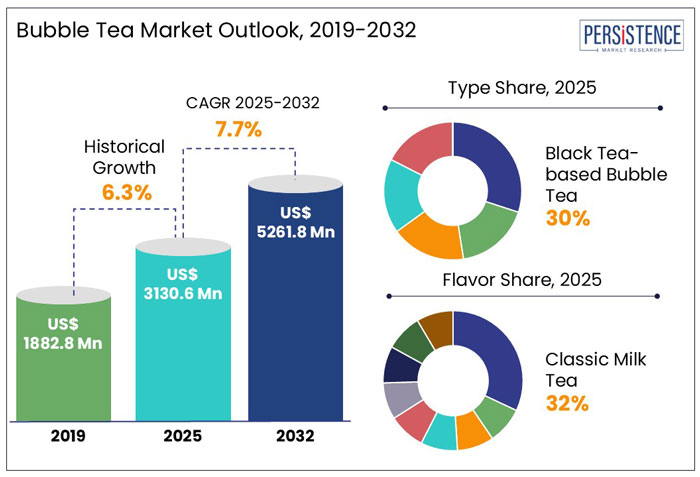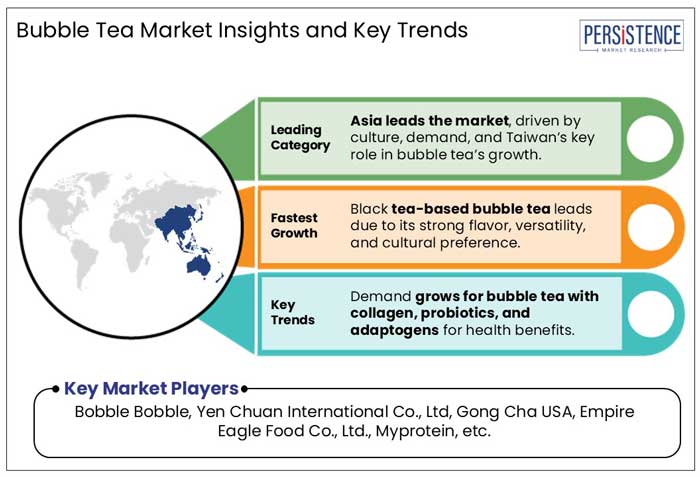Industry: Food and Beverages
Published Date: February-2025
Format: PPT*, PDF, EXCEL
Delivery Timelines: Contact Sales
Number of Pages: 400
Report ID: PMRREP31358
The Global Bubble Tea Market is expected to grow from US$3,130.6 Mn in 2025 to US$5,261.8 Mn in 2032, at a substantial CAGR of 7.7% from 2025 to 2032.

|
Attribute |
Details |
|
Bubble Tea Market Size (2025E) |
US$ 3,130.6 Mn |
|
Projected Sales of Bubble Tea (2032F) |
US$ 5,261.8 Mn |
|
Value CAGR (2025-2032) |
7.7% |
|
Value Share of Top 5 Countries (2024A) |
53% |
According to Persistence Market Research, the global bubble tea market is experiencing rapid expansion, driven by evolving consumer preferences, a growing café culture, and increasing demand for customizable beverages. Originating in Taiwan, bubble tea has transitioned from a niche Asian drink to a mainstream global phenomenon, with innovative flavors and healthier alternatives fueling its popularity. The market is witnessing a surge in non-dairy and plant-based options, catering to lactose-intolerant and vegan consumers.
The bubble tea market has experienced a remarkable transformation over the years, evolving from a niche Taiwanese specialty to a global sensation. Initially popularized in Asia, particularly in Taiwan, Hong Kong, and China, the drink gained traction internationally due to its customizable flavors, unique texture from tapioca pearls, and appeal among younger demographics. The market’s historical growth has been driven by increasing urbanization, rising disposable incomes, and the proliferation of specialty tea chains, which positioned bubble tea as both a trendy beverage and a lifestyle choice. The expansion of franchise-based bubble tea brands, particularly in North America and Europe, further propelled its popularity.
The market is set to witness continued expansion, fueled by increasing consumer demand for innovative beverages, healthier formulations, and plant-based milk alternatives. The integration of functional ingredients such as collagen, probiotics, and herbal infusions is expected to reshape the industry, catering to health-conscious consumers while retaining its indulgent appeal.
“Use of Healthy Ingredients Driving Bubble Tea Consumption”
Consumer preferences in the beverage industry are rapidly changing. People are seeking foods and beverages that have healthy ingredients as they become more aware of health and health-related issues. As a result, bubble tea manufacturers are focusing on using distinctive and fresh ingredients such as fresh fruits, organic cream, soy milk, and various others. The nutritional content, flavor, and texture of bubble tea are all being improved with these ingredients.
Milk tea has a variety of health benefits, such as adding milk to any beverage is not only delicious but also good for health. Bubble tea contains beneficial properties such as antioxidants and calcium, which provide body strength and make the bones strong.
The carbohydrate content in bubble tea is one of the primary sources of energy required for the brain. It also serves as fuel to the heart muscles and the central nervous system. As a majority of people are working professionals, there are a lot of stressful activities during the day which need to be fulfilled.
Drinking boba tea reduces the tension in the muscles in the body, making it possible to carry out regular tasks easily. It also contains caffeine, which refreshes the body to improve memory and mental functioning of the body.
One of the health benefits of bubble tea is that it boosts the immune system and includes a wide range of antioxidants that prevent oxidative stress from accumulating. Fresh fruits, such as passionfruit and strawberry, can also be added to bubble tea for a variety of adaptations.
Obesity and diabetes, which are also typically linked to sugar consumption, have prompted customers to switch to sugar substitutes such as stevia, agave, and honey. These natural sweeteners are increasingly being used to replace sugar in bubble tea drinks. This is excellent news for health-conscious people and the diabetic population.
“Rising Popularity of Cafés & Quick Service Restaurants Propelling Demand for Bubble Tea”
Rising demand for bubble tea is largely attributable to the expanding popularity of cafés and quick service restaurants in Asia, particularly due to Starbucks' rapid development in the region. Following the launch of companies such as Chatime, Koi, and Tiger Sugar, among others, in cities across Asia that offer the bubble tea version of café culture, the bubble tea fad has only increased.
Coffee shops and cafés are the fastest-growing food service categories, particularly in South Asia and Pacific countries. Because of its unique flavors, convenience, and personalized requirements, consumers in this region are predicted to consume more bubble tea. Sales of bubble tea beverages are likely to increase due to the growing popularity of café culture and consumer demand for innovative and unique food and beverage products.
Multinational bubble tea café and foodservice firms are focusing on growing their outlets in emerging markets to attract more customers. Untapped countries are likely to provide significant growth opportunities for bubble tea suppliers.
The cost to make one cup of bubble tea is minimal. Ingredients such as tapioca pearls, bubble tea powder, and tea leaves are purchased in bulk, which helps make huge quantities of bubble tea at less cost. Moreover, teas may include multiple toppings besides the standard boba, including flavored jellies, red beans, and puddings.
“Market Players Releasing New Innovative Bubble Tea Flavors”
To appeal to the millennial generation, companies are focusing on introducing creative beverages with a variety of flavors such as apple, dry fruits, milk flavors, and many more. Manufacturers have an opportunity to introduce new flavored drinks into the market because millennials are known for their excitement to try new flavors.
Lowering sugar intake or substituting brown sugar for artificial sweeteners can be beneficial, but it is not without risk. Choosing the right ingredients and minimizing the sugar level, in combination with other healthy flavoring syrup options, can be helpful to health. It is always better to consume bubble tea in moderation, even if there is a healthier version of regular bubble tea.
Over the forecast period, sales of bubble tea are expected to grow as flavored bubble tea offers a strong potential for manufacturers. Companies are also focusing on reaching the consumer base in several untapped markets to generate sales and increase revenue.
There are several regions where bubble tea is exported from other countries. As a result, premium products have a higher cost, which has an impact on the sales in these areas. Companies are concentrating their efforts on expanding and manufacturing premium bubble tea in these regions, leading to comparatively low costs.
Low market penetration in a few places, along with the high costs of premium goods provides an opportunity for bubble tea drink manufacturers to expand in untapped markets.
“High Preference for Healthy Beverages Might Hamper Market Expansion”
Bubble tea has a higher sugar content as compared to other drinks, and consumers are becoming more conscious of the negative health effects of too much sugar in these drinks, which can lead to health problems.
Bubble tea has approximately 400 calories; hence it's not something that should be consumed on a regular basis. This high sugar level can lead to diabetes, tooth decay, and deterioration in the body's immunity. It is also high in carbohydrates and lacks all the vital nutrients such as vitamins, minerals, fiber, etc.
Various specialists have highlighted how high-calorie calculations might harm one's health if ingested daily, and this is predicted to limit bubble tea market growth. Furthermore, customers are shifting their preferences toward organic beverages as a result of the presence of artificial preservatives in some bubble tea variants, hampering global bubble tea market growth.
Which region holds a major share in the bubble tea market?
The Asian region leads the bubble tea market due to a combination of deep-rooted cultural affinity for tea, a rapidly evolving café culture, and strong domestic brand proliferation. Taiwan, the birthplace of bubble tea, continues to be a global trendsetter, innovating with new flavors, textures, and ingredient combinations that drive consumer excitement. China, with its vast urban population, has fueled the market’s expansion, as chains like Mixue Bingcheng and Heytea dominate city streets with affordable and premium-tier bubble tea offerings.
Which is the emerging country in bubble tea market?
The United States is an emerging market in the bubble tea industry due to a combination of demographic shifts, changing consumer preferences, and expanding retail presence. The growing Asian-American population, particularly in cities like Los Angeles, New York, and San Francisco, has played a crucial role in introducing and popularizing bubble tea among a wider audience. Additionally, the rise of health-conscious modifications, such as reduced-sugar options, oat milk substitutes, and organic tea bases, has helped bubble tea appeal to a broader demographic, including millennials and Gen Z consumers who prioritize wellness without sacrificing indulgence.
Which Bubble Tea Toppings are Most Popular?
Based on type, black tea-based bubble tea holds the largest share among the base ingredients in the bubble tea market. This dominance is attributed to black tea's robust flavor, widespread availability, and versatility, making it a popular choice for consumers seeking both traditional and innovative taste experiences.

Prominent manufacturers of bubble tea are focusing on expanding their market share by entering new markets. This helps them gain a competitive advantage and allows them to establish multiple revenue streams, which allows them to create branding opportunities.
|
Attribute |
Details |
|
Forecast period |
2025-2032 |
|
Historical data available for |
2019-2024 |
|
Market Analysis Units |
Value: US$ Bn/Mn, Volume: As applicable |
|
Key regions covered |
|
|
Key market segments covered |
|
|
Key companies profiled |
|
|
Report Highlights |
|
|
Customization & pricing |
Available upon request |
By Type:
By Flavor:
By Distribution Channel:
By Region:
To know more about delivery timeline for this report Contact Sales

The global bubble tea market is currently valued at over US$ 3,130.6 Mn.
Increasing use of healthy ingredients, rising popularity of cafés and quick service restaurants, manufacturers highlighting the health benefits of bubble tea, and steady shift in consumer preference toward flavored teas are bolstering demand for bubble tea.
From 2019 to 2024, bubble tea sales increased at a CAGR of 6.5%.
Sales of bubble tea are projected to surge at 7.7% CAGR and be valued at US$ 5,261.8 Mn by 2032.
Top producers of bubble tea include Tea Ren's Tea Time, Lollicup USA, Chatime, YiFang Bubble Tea, and Kung Fu Bubble Tea, together accounting for an approximate market share of 5%-15%.
The U.K. bubble tea market in Europe is predicted to progress at around 8.2% CAGR.
The U.S., ASEAN, China, India, and Canada account for highest bubble tea consumption.
The North America bubble tea market is anticipated to reach 84,159 tons by the end of 2032.
The Oceania bubble tea market is anticipated to reach US$ 126.5 Mn by 2032.